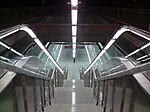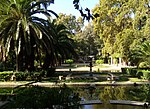Los Remedios

Los Remedios is a district of Seville, the regional capital of Andalusia, Spain. It is located on the Isla de La Cartuja, south of the district of Triana, between two forks of the Guadalquivir river. It is linked by bridge to the city centre (Casco Antiguo) and the districts of Distrito Sur and Bellavista-La Palmera. From the western side of the island, it is linked by road bridge to the city of San Juan de Aznalfarache and shares a boundary in the Guadalquivir with the city of Gelves. The southern tip of La Cartuja is opposite the municipality of Dos Hermanas. Los Remedios takes its name from a Carmelite convent of the same name found in the district. Before urban development in the latter half of the 20th century, the convent was one of the few structures in what is now Los Remedios. The Port of Seville has been located in this district since silting forced it to leave the El Arenal neighbourhood in the city centre.
Excerpt from the Wikipedia article Los Remedios (License: CC BY-SA 3.0, Authors, Images).Los Remedios
Calle Virgen de Luján, Seville Los Remedios
Geographical coordinates (GPS) Address Nearby Places Show on map
Geographical coordinates (GPS)
| Latitude | Longitude |
|---|---|
| N 37.3747 ° | E -5.9975583333333 ° |
Address
Calle Virgen de Luján 15
41011 Seville, Los Remedios
Andalusia, Spain
Open on Google Maps











